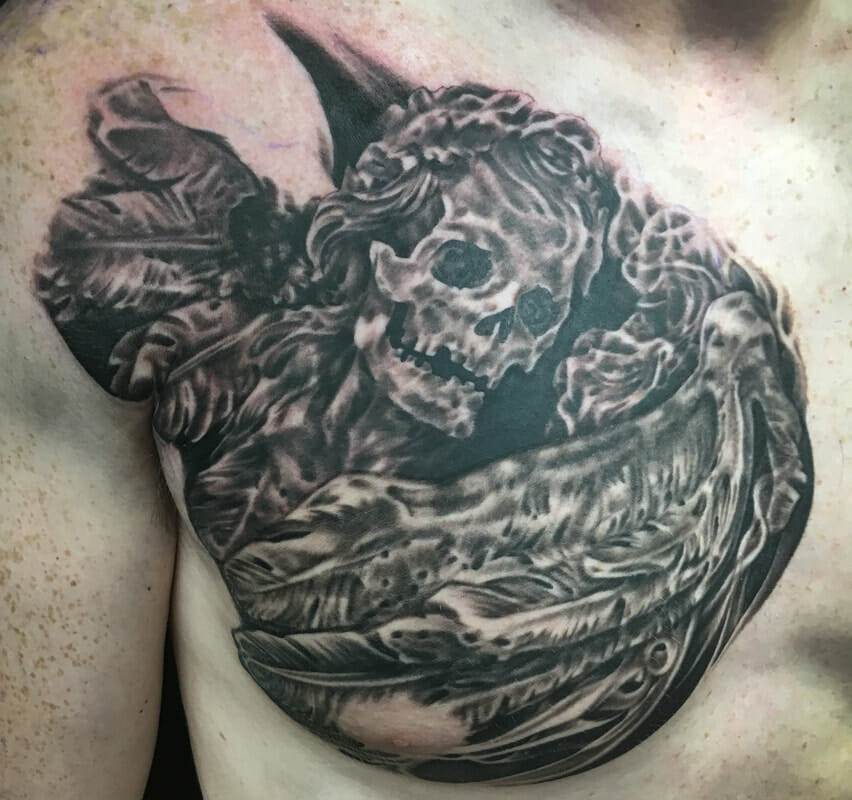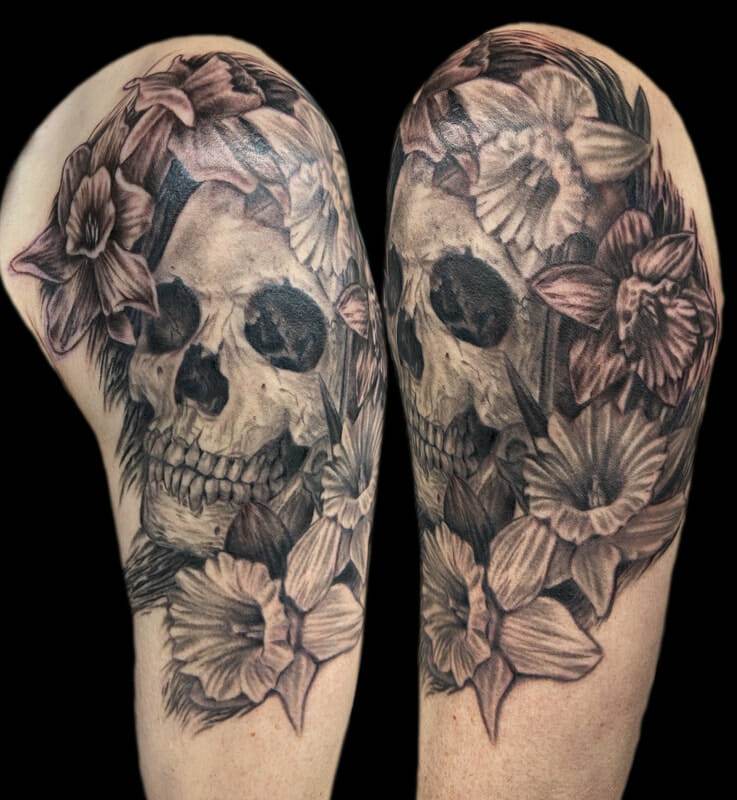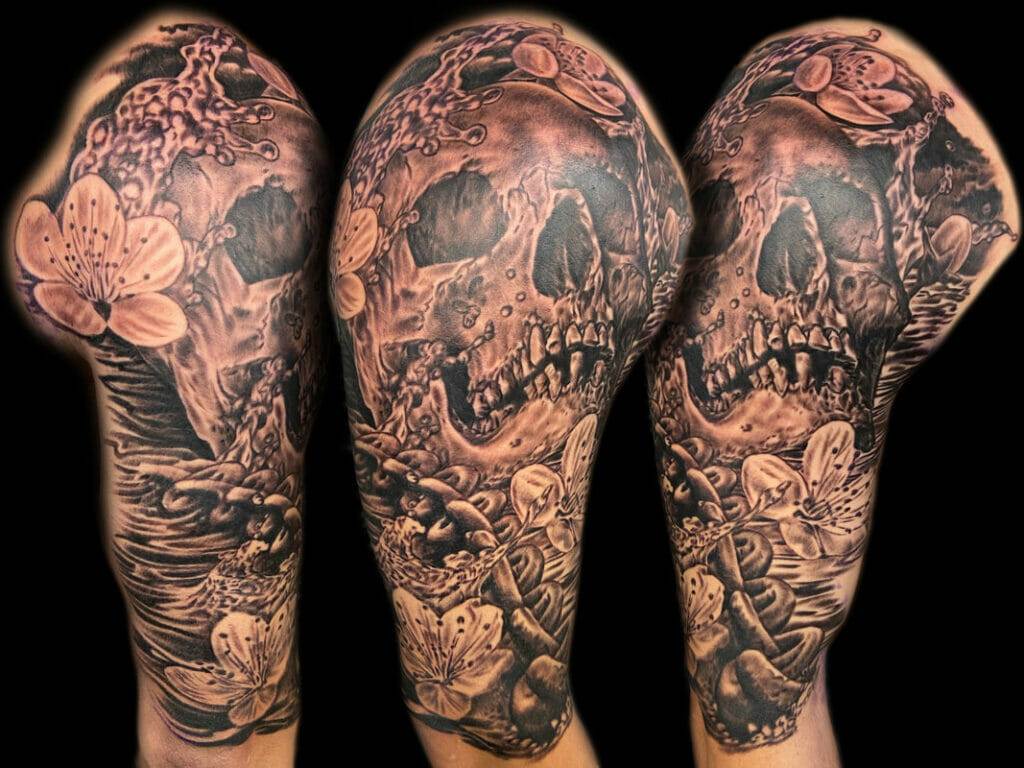Horror and body art are two forms of self-expression that have long been intertwined. Both allow individuals to express their innermost thoughts, emotions, and fears in a visual and tangible way. The appeal of horror-inspired designs in body art lies in the ability to create a lasting tribute to one’s favorite horror characters, themes, or concepts. Whether it’s a tattoo of a classic horror movie monster or a piercing inspired by a gruesome scene, horror-inspired body art allows individuals to showcase their love for the genre while also making a personal statement about their own identity.
The Evolution of Horror-Inspired Body Art: From Traditional to Modern
The history of horror-inspired body art can be traced back to traditional tattoo designs. In the early days of tattooing, horror themes were often depicted through dark and macabre imagery such as skulls, demons, and monsters. These designs were often done in black ink and had a bold and graphic style.
However, with the rise of modern horror films, body art began to evolve and take on new forms. The influence of movies like “Nightmare on Elm Street” and “Halloween” brought iconic horror characters like Freddy Krueger and Michael Myers into the world of tattoos. These characters became popular choices for body art enthusiasts looking to pay homage to their favorite films.
As the popularity of horror-inspired body art grew, so did the emergence of new styles and techniques. Artists began experimenting with different color palettes, shading techniques, and even incorporating elements of realism into their designs. This allowed for more detailed and intricate horror-inspired tattoos that captured the essence of the genre in a whole new way.
Iconic Horror Characters as Tattoos: The Freddy Kruegers and Michael Myers of the Ink World
One of the most popular aspects of horror-inspired body art is the depiction of iconic horror characters as tattoos. Characters like Freddy Krueger, Michael Myers, and Jason Voorhees have become synonymous with the horror genre and have a dedicated fan base. Having a tattoo of one of these characters is not only a way to show one’s love for the films but also a way to pay tribute to the impact these characters have had on horror culture.
The significance of these characters in horror culture cannot be overstated. They have become symbols of fear, terror, and the human psyche. Each character represents a different aspect of horror, whether it’s Freddy Krueger’s ability to invade dreams or Michael Myers’ relentless pursuit of his victims. Having a permanent tribute to these characters allows individuals to carry a piece of the horror genre with them wherever they go.
The appeal of having a permanent tribute to a favorite horror character goes beyond just being a fan. It can also serve as a reminder of personal experiences and emotions. For example, someone who has overcome their own fears or struggles may choose to get a tattoo of a horror character as a symbol of their strength and resilience. Horror-inspired body art can be deeply personal and meaningful, allowing individuals to express themselves in a unique and powerful way.
The Psychology of Fear: How Horror-Inspired Body Art Reflects Our Deepest Anxieties
Horror and fear are deeply intertwined, and horror-inspired body art can be seen as a way to confront and overcome our deepest anxieties. The connection between horror and fear lies in the fact that both tap into our primal instincts and evoke intense emotions. By choosing to get horror-inspired body art, individuals are embracing their fears and using them as a source of empowerment.
For some, horror-inspired body art can be therapeutic. It allows individuals to face their fears head-on and take control over them. By immortalizing their fears in the form of body art, individuals are able to confront their anxieties in a tangible way. This can be a cathartic experience and can help individuals process and overcome their fears.
Additionally, horror-inspired body art can also serve as a form of self-expression and a way to communicate one’s identity. By choosing to get a horror-inspired tattoo or body modification, individuals are making a statement about who they are and what they value. It can be a way to show their love for the horror genre, their fascination with the macabre, or their desire to embrace their darker side. Horror-inspired body art allows individuals to express themselves in a unique and powerful way, while also confronting their fears and anxieties.
The Role of Color in Horror-Inspired Body Art: From Blood Red to Ghostly White
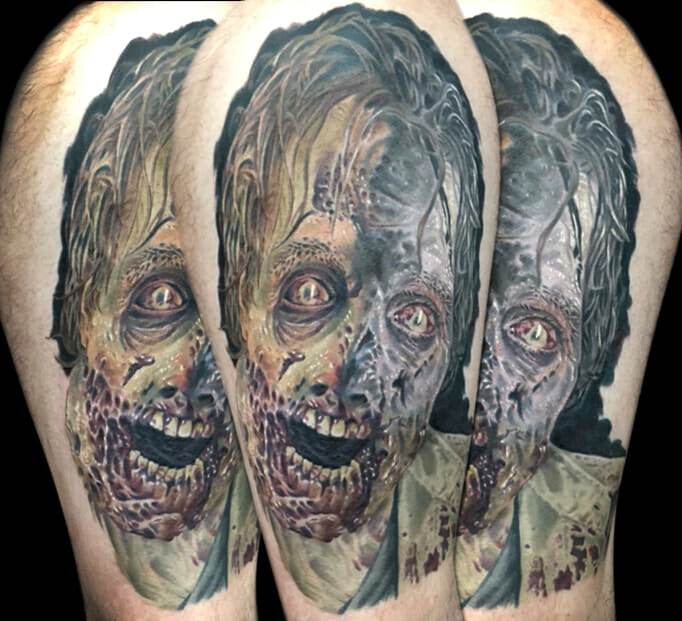
Color plays a crucial role in horror-inspired body art. It can enhance the overall effect of a design and evoke specific emotions or moods. Different colors have different meanings in horror culture, and artists often use color strategically to create a desired effect.
For example, blood red is often used to symbolize violence, danger, and death. It can evoke feelings of fear, intensity, and unease. Black is another commonly used color in horror-inspired body art, representing darkness, mystery, and the unknown. It can create a sense of foreboding and add depth and contrast to a design.
On the other hand, ghostly white is often used to represent the supernatural or otherworldly. It can create an ethereal and haunting effect, adding an element of mystery and intrigue to a design. Other colors such as green (often associated with monsters or zombies) or purple (often associated with magic or the occult) can also be used to enhance the overall theme or concept of a horror-inspired design.
The use of color in horror-inspired body art is not only aesthetically pleasing but also adds layers of meaning and symbolism to the design. It allows individuals to further express their emotions, fears, and desires through the use of color, creating a more impactful and visually striking piece of body art.
The Rise of Horror-Inspired Body Art in Pop Culture: From Film to Fashion
The influence of horror films on popular culture cannot be denied, and this influence extends to the world of body art. As horror films gained popularity, so did the desire to incorporate elements of the genre into other forms of self-expression, including fashion and body art.
Horror-inspired clothing and accessories have become increasingly popular, with brands like Blackcraft Cult and Killstar leading the way. These brands offer a wide range of clothing and accessories featuring horror-inspired designs, from t-shirts with iconic horror characters to jewelry with macabre motifs. This allows individuals to showcase their love for the genre in their everyday style.
Social media has also played a significant role in the rise of horror-inspired body art in pop culture. Platforms like Instagram and Pinterest have allowed artists and enthusiasts to share their work and connect with others who share their passion for horror-inspired designs. This has created a sense of community and has helped to further popularize horror-inspired body art.
The rise of horror-inspired body art in pop culture is a testament to the enduring appeal of the genre. It has become more than just a niche interest; it has become a mainstream form of self-expression that allows individuals to showcase their love for horror in a unique and visually striking way.
Horror-Inspired Body Art for Self-Expression: The Personal Meanings Behind the Scary Designs
While horror-inspired body art may seem intimidating or scary to some, it holds deep personal meanings for those who choose to get it. Each design represents something unique to the individual, whether it’s a personal experience, an emotion, or a connection to the horror genre.
For some, horror-inspired body art can be a way to express their own fears or anxieties. It can serve as a reminder of past traumas or struggles and can be a way to confront and overcome them. By choosing to get a horror-inspired tattoo or body modification, individuals are reclaiming their fears and turning them into something empowering.
Others may choose horror-inspired body art as a way to pay tribute to their favorite horror films, characters, or themes. It can be a way to show their love for the genre and their appreciation for the impact it has had on their lives. Horror-inspired body art allows individuals to connect with others who share their passion and serves as a visual representation of their identity.
Ultimately, horror-inspired body art is a deeply personal form of self-expression. It allows individuals to showcase their fears, passions, and experiences in a unique and visually striking way. It is a testament to the power of art to communicate complex emotions and ideas, and it serves as a reminder that beauty can be found even in the darkest corners of our imagination.
The Art of Horror-Inspired Body Modification: Piercings, Scarification, and More
While tattoos are the most common form of horror-inspired body art, there are other forms of body modification that also draw inspiration from the horror genre. Piercings, scarification, and even implants can be used to create unique and visually striking horror-inspired designs.
Piercings can be strategically placed to create the illusion of wounds or scars, adding an element of realism to a horror-inspired design. For example, piercings placed around the mouth or eyes can create the appearance of stitches or cuts. This type of body modification allows individuals to push the boundaries of traditional body art and create truly unique and innovative designs.
Scarification is another form of body modification that draws inspiration from the horror genre. It involves intentionally cutting or branding the skin to create permanent scars. These scars can be shaped into intricate designs or patterns, adding a macabre and visually striking element to the body.
Implants, such as subdermal horns or spikes, can also be used to create horror-inspired body modifications. These implants are placed under the skin and can create a dramatic and otherworldly effect. They can be shaped into various forms, such as devil horns or fangs, adding an element of fantasy and horror to the body.
It is important to note that these forms of body modification carry risks and should only be performed by experienced professionals. It is crucial to do thorough research and choose a reputable artist or piercer who has experience in these specific types of body modification. Safety should always be the top priority when considering any form of body modification.
The Controversy of Horror-Inspired Body Art: Criticisms and Concerns
As with any form of self-expression, horror-inspired body art is not without its criticisms and concerns. Some argue that it promotes violence, glorifies death, or perpetuates negative stereotypes about the horror genre. Others may view it as inappropriate or offensive, especially in certain cultural or religious contexts.
It is important to approach horror-inspired body art with sensitivity and respect for different perspectives. While it may hold personal meaning for some, it is essential to consider how it may be perceived by others. Responsible and ethical practices in body art involve open communication with clients, ensuring that they understand the potential impact of their chosen design and are comfortable with any potential criticisms or concerns.
Additionally, it is crucial to consider the long-term implications of horror-inspired body art. While a design may hold personal significance at the time it is chosen, individuals should carefully consider how it may be perceived in the future. It is important to choose designs that will stand the test of time and continue to hold personal meaning throughout one’s life.
Horror-Inspired Body Art Around the World: Cultural Influences and Variations
Horror-inspired body art is not limited to any specific culture or region. It can be found in various forms and variations around the world, each influenced by the unique cultural context in which it exists.
In Japan, for example, horror-inspired body art often draws inspiration from traditional Japanese folklore and ghost stories. Designs may feature yokai (supernatural creatures), oni (demons), or yurei (ghosts). These designs often have a distinct style and symbolism that is deeply rooted in Japanese culture.
In Mexico, horror-inspired body art is often associated with the Day of the Dead (Dia de los Muertos) celebration. Designs may feature sugar skulls, skeletons, or other macabre motifs. These designs are not meant to be scary or frightening but rather to honor and remember loved ones who have passed away.
In Western cultures, horror-inspired body art often draws inspiration from classic horror films and iconic characters. Designs may feature images of vampires, werewolves, or zombies. These designs are often bold and graphic, with a focus on creating a visually striking and impactful design.
The cultural influences on horror-inspired body art are vast and varied, and each region or country brings its own unique perspective to the genre. Understanding and appreciating these cultural influences is crucial in order to fully understand the significance of horror-inspired body art.
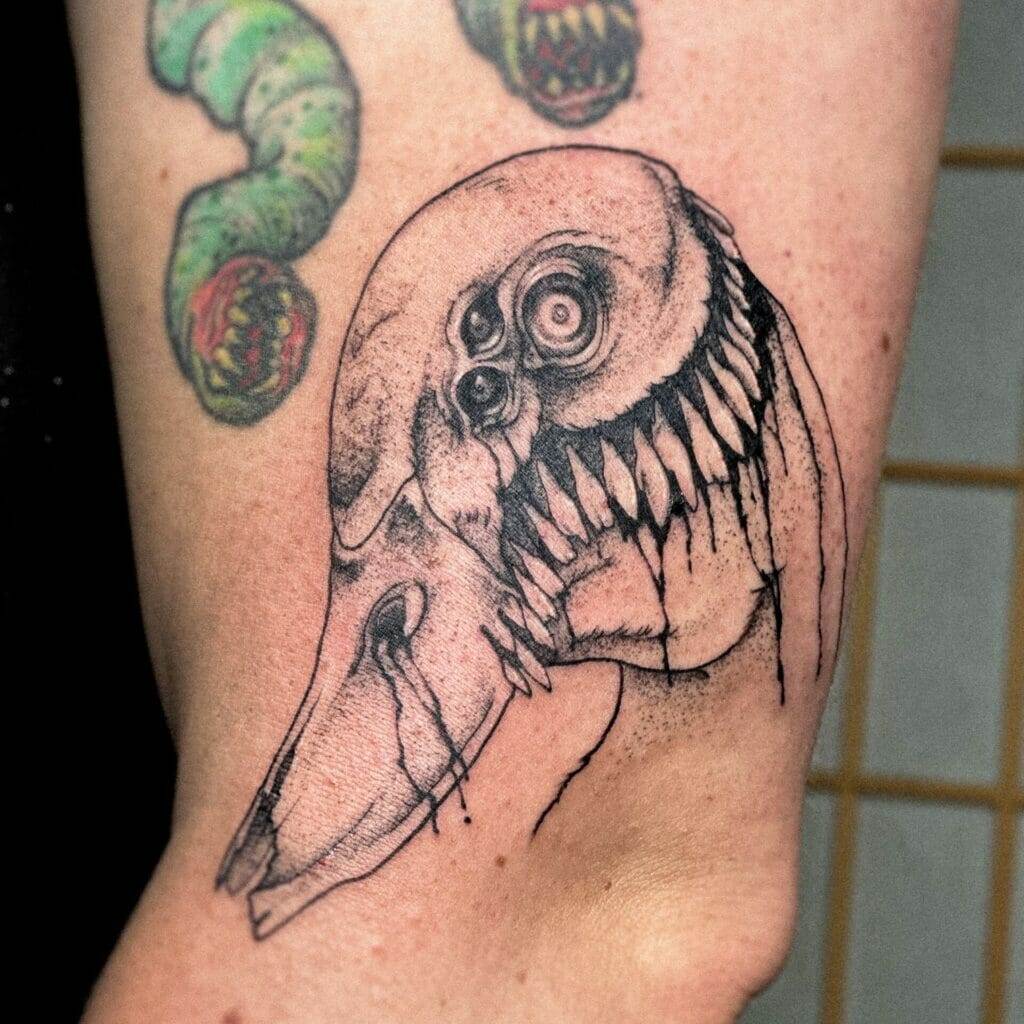
The Enduring Appeal of Horror-Inspired Body Art and Its Place in the Art World
Horror-inspired body art has an enduring appeal that goes beyond just being a trend or a passing fad. It allows individuals to express their deepest fears, passions, and emotions in a unique and visually striking way. It serves as a form of self-expression that is deeply personal and meaningful to those who choose to get it.
As horror films continue to captivate audiences and influence popular culture, the popularity of horror-inspired body art is likely to continue to grow. It has already gained recognition as a legitimate form of art, with artists pushing the boundaries of traditional body art and creating truly innovative and visually stunning designs.
Understanding and appreciating the cultural significance of horror-inspired body art is crucial in order to fully appreciate its place in the art world. It is a form of self-expression that allows individuals to confront their fears, pay tribute to their favorite horror characters or themes, and communicate their identity in a unique and powerful way. Horror-inspired body art is a testament to the power of art to evoke emotions, challenge societal norms, and create lasting connections between individuals.

